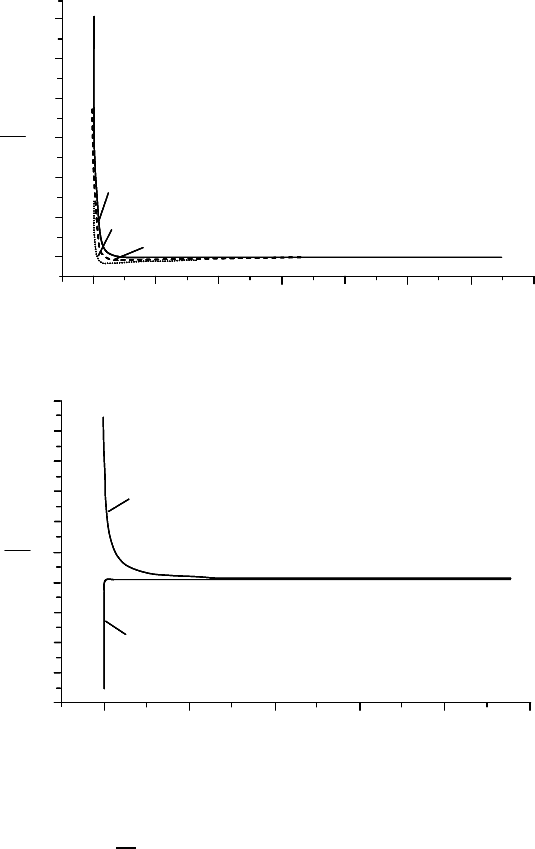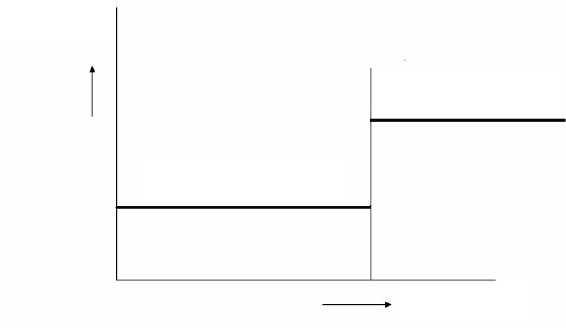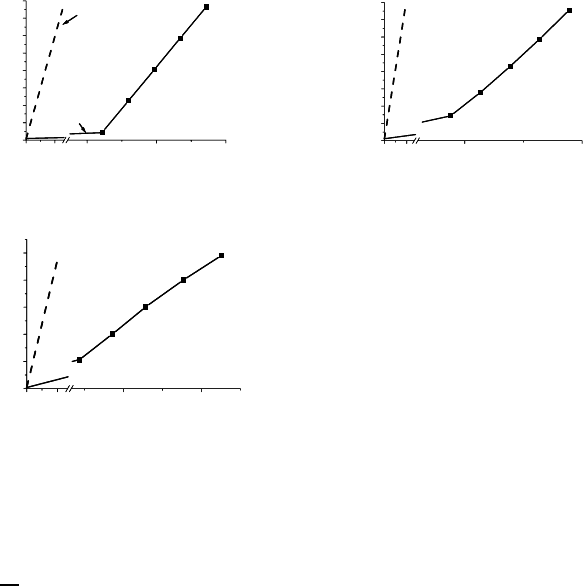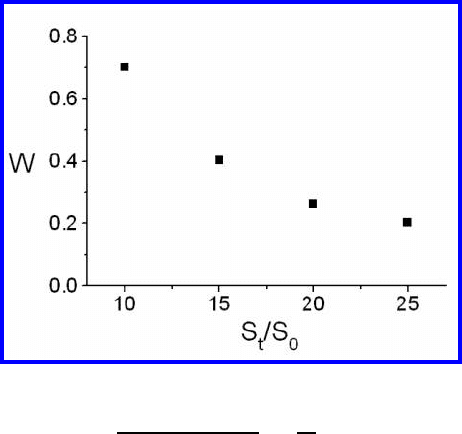Gottstein G., Shvindlerman L.S. Grain Boundary Migration in Metals: Thermodynamics, Kinetics, Applications
Подождите немного. Документ загружается.


576 6 Applications
of the metals and the temperature of motion. Let us estimate the dimen-
sionless criterion λ
junctions,b
using the particular value of quadruple junction
mobility
m
qp
≈ 2 · 10
−4
s
−1
and grain boundary and triple junction mobil-
ity for Al (Table 4.4, 110 tilt grain boundary) at 200
◦
C.Onecanseethat
for
¯
R =10
−8
mandγ =0.5J/m
2
the criteria are equal to
Λ
tj
=10
−13
;
Λ
qp
=3· 10
−6
and
Λ
junctions,b
=10
−13
It is obvious that the main contribution to λ
junctions,b
comes from triple junc-
tions drag. It is stressed that the effects of the different grain boundary junc-
tions are closely connected; indeed,
Λ
qp
=
m
qp
¯
R
m
tj
Λ
tj
(6.86)
At high temperatures where the mobility of the triple junctions due to their
high activation enthalpy is large, the major drag of grain growth in nanocrys-
talline materials is exerted by quadruple junctions whereas at rather low tem-
perature the retardation is affected by triple junctions
Owing to the loss of excess volume during grain growth, vacancies are gener-
ated to temporarily compensate the volume change. This leads to a drag effect
during grain growth [12], [458]–[460] (see Chapter 4). The criterion λ
vac,b
for
this type of drag can be expressed as
λ
vac,b
=
m
beff
γπ(n − 6)/3
m
b
γπ(n − 6)/3
=
D
SD
A
b
1
36
¯
Rγ
NkTZ(V
ex
)
2
(6.87)
where A
b
= m
b
γ is the reduced grain boundary mobility, N is the number of
the atoms per unit volume, Z is the coordination number, D
SD
is the bulk
self-diffusion coefficient, V
ex
is the grain boundary excess free volume. For
pure Al at 300
◦
C λ
vac,b
≈ 10
3
R,andfor
¯
R ≈ 10
−8
m this yields λ
vac,b
≈ 10
−5
.
In general two types of particle drag effects on grain growth should be
considered: the drag by small mobile particles and by large immobile particles.
However, the consideration in [612] is confined to nanocrystalline materials.
The grain size in nanostructures is so small that it is difficult to imagine the
existence of large immobile particles which are comparable in size with the
grains. That is why only the drag by particles moving jointly with the grain
boundaries was analyzed in [612]. The velocity of a grain boundary moving
together with particles is given in Chapter 3 Eq. (3.71). The effective mobility
of such a grain boundary can be expressed as
m
eff
=
m
p
(r
0
)
n
0
(6.88)
© 2010 by Taylor and Francis Group, LLC

6.5 Grain Boundary Junction Engineering 577
where m
p
(r
0
) is the mobility of particles of radius r
0
,andn
0
is the number
of particles per unit area of the boundary, respectively. For the second-phase
particles considered in [612], the criterion λ
part,b
can be represented as [607]
λ
part,b
=
dS
dt
-
-
part
dS
dt
-
-
b
=
m
beff
m
b
=
m
p
(r)
n
·
1
m
b
(6.89)
where the number of second-phase particles n is determined by the phase
diagram and the cooling interval. As shown in [612] for a system with rather
small solubility the criterion λ
part,b
canbeexpressedasλ
part,b
∼
=
10
−15
m
2
r
2
.In
other words, only “sufficiently large” particles will exert an efficient drag on
grain growth in nanocrystalline systems.
It is of interest to consider the relative efficiency of particles and triple
junctions on retardation of grain growth. The relation which describes the
relative efficiency of triple junction drag compared to mobile particle drag
was derived in [612]:
λ
tj,p
=
3
4
m
tj
¯
R
4m
beff
=
3
4
m
tj
πm
p
(r
0
) r
0
(6.90)
With the same values of the parameters used in the evaluations discussed
above, relation (6.90) can be transformed to
λ
tj,part
≈ 2 · 10
15
m
−3
· r
3
(6.91)
Obviously, triple junction drag becomes comparable with particle drag only
for r ≥ 10
−5
m, in other words for very large particles, r>10 μm.
From this analysis it can be concluded that grain boundary junctions are
most effective for microstructural stabilization of very fine-grained microstruc-
tures in the range of the used parameters.
6.5 Grain Boundary Junction Engineering
The concept of grain boundary engineering (GBE) has been embodied in
the papers of the groups of Watanabe and Palumbo, respectively [614]–[618].
The practical realization of this idea was reduced to thermomechanical treat-
ment, most often to the thermocycling. Such treatment results in an increase
in the number of special grain boundaries, predominantly twin boundaries.
While not questioning the prospects of such an approach the authors would
like to call the reader’s attention to the fact that a deeper understanding
of well-known processes or physical phenomena which permit us to create
materials with given properties and (or) distribution of grain boundaries is
© 2010 by Taylor and Francis Group, LLC

578 6 Applications
subsumed under GBE as well. Strictly speaking, all processes which trans-
form the properties of materials due to a change in grain boundary properties
and distribution, in other words, in grain microstructure — recovery, recrys-
tallization and especially grain growth — fall in this category. This is our
understanding of GBE. In particular, the essential difference between grain
microstructure obtained during grain growth under different regimes — triple
junction regime and grain boundary kinetics — indicates that there is a way
to utilize this behavior to influence microstructural evolution, which will be
referred to as grain boundary junction engineering, that utilizes junction prop-
erties for microstructure control [447]. Grain boundary junction engineering
is a new branch of GBE. The consideration given in [619] is confined to grain
growth. Grain growth affects the grain microstructure but its development
depends on the internal parameters of the sample — chemical nature of the
matrix, i.e. impurities, composition — and the characteristics of the process
— temperature, pressure, time of annealing. To generate the desired grain
microstructure is only half of the problem. It is equally important to stabilize
the formed microstructure. This issue is of special importance for ultrafine-
grained and nanocrystalline materials. To stabilize a small grain size usually
drag forces by impurities or particles are introduced. However, both methods
require a special phase and chemical composition of the material on the one
hand, and change, as a consequence, its physical and mechanical properties
(see Chapter 6). In [619] another approach is proposed, based on the essential
difference in grain microstructures formed by junction kinetics and by bound-
ary kinetics. The theoretical foundations of grain boundary junctions kinetics
and the special features of grain growth affected by boundary junctions are
considered comprehensively in Chapter 4. Here we would like to dwell on some
aspects of the problem.
As shown in Chapter 4, in the course of grain growth influenced by triple
junctions the grains with a number of sides n with n
∗
L
<n<n
∗
H
become
locked and can neither grow nor shrink. The influence of such a “layer” of
locked grains on the stability of grain microstructure will be more severe for
fine-grained and nanocrystalline materials.
It is emphasized repeatedly that a limited triple junction mobility always
slows down the evolution of the grain microstructure of polycrystals, irrespec-
tive whether the topological class of the considered grain is smaller or larger
than 6. However, the finite mobility of triple junctions not only slows down
grain microstructure evolution, it changes the final distribution of the grains
of different topological classes, as well. Actually, relation (4.74) provides a way
of estimating the time dependence of the criterion Λ [447, 619]
˙
S =
dS
dR
·
dR
dΛ
·
dΛ
dt
=2
α
S
α
Λ
R
m
b
m
tj
dΛ
dt
= β
· Λ ·
dΛ
dt
(6.92)
© 2010 by Taylor and Francis Group, LLC

6.5 Grain Boundary Junction Engineering 579
where β
=2
α
S
m
2
b
α
Λ
m
2
tj
, α
S
and α
Λ
are geometrical coefficients of the order of
one. From (6.92) and (4.74) we arrive at
dΛ
dt
= −β ·
2π − n (π − 2θ)
Λ
(6.93)
where β =
A
b
β
.
The rate of change of the parameter Λ depends on the topological class n
of a grain. A more specific relation for
dΛ
dt
can be obtained in the vicinity of
θ = π/3 (see Chapter 4).
The temporal change of Λ during grain growth is given in Fig. 6.48. It
can be seen from Fig. 6.48 and Eq. (6.93) that triple junction drag affects the
growth of grains with different topological class n markedly different. Further-
more, Fig. 6.48 illustrates that the junction drag eliminates the unique border
between growing and shrinking grains: for rather small Λ the derivative
dΛ
dt
is positive for n = 5 and negative for n = 7. This issue is the key for under-
standing the influence of triple junctions on grain microstructure evolution.
Moreover, this effect provides another explanation of abnormal grain growth
in fine grained materials. Namely, a grain of rather large topological class will
break free of triple junction drag and will start to grow at boundary kinetics
much faster than the grains with small or not so large n.Evidently,sucha
strong acceleration of the growth of an individual grain is characteristic of
abnormal grain growth. A possible way of junction kinetics treatment (JKT)
is schematically depicted in Fig. 6.49, which illustrates a sequence of anneal-
ings. As shown in Chapter 4, the annealing at a relatively low temperature
initiates grain growth at triple junction kinetics, and the grain microstructure
resulting from this treatment is a typical “junction” microstructure, a system
of polygonal grains which tends to assume an equilateral shape, etc. Fig. 6.49
presents the results of grain growth studied by computer simulations. Evi-
dently, a subsequent annealing at boundary kinetics conditions (subsequent
to junction kinetics) requires a much larger time to reach the same grain
size. An increase in the effect of JKT as expressed by the grain area ratio
after junction-controlled growth, S
t
/S
0
, conspicuously delays regular grain
growth under boundary kinetics. This phenomenon can be seen more clearly
in Fig. 6.50, where the ratio of the growth rates with and without JKT is
presented for different W =
d(S
t
/S
0
)/dt
afterJkT
d(S
t
/S
0
)/dt
bk
.ThenumeratorofW is the
slope of the time dependency of the mean grain area change after JKT, while
the denominator is the rate of mean grain area change at boundary kinetics.
The value W
−1
is a measure for the stabilization of the grain microstructure
in the course of such a treatment.
© 2010 by Taylor and Francis Group, LLC

580 6 Applications
d
dt
Λ
12
Λ
n = 5
10
8
6
2
0
4
40
0
20
60
80
100
120
140
n = 3
n = 4
(a)
(b)
n = 12
n = 7
100
10
12
4
6
8
0
2
-4
-2
-8
-6
0
20
80
6040
d
dt
Λ
Λ
d
dt
Λ
12
Λ
n = 5
10
8
6
2
0
4
40
0
20
60
80
100
120
140
n = 3
n = 4
d
dt
Λ
12
Λ
n = 5
10
8
6
2
0
4
40
0
20
60
80
100
120
140
n = 3
n = 4
(a)
(b)
n = 12
n = 7
100
10
12
4
6
8
0
2
-4
-2
-8
-6
0
20
80
6040
d
dt
Λ
Λ
n = 12
n = 7
100
10
12
4
6
8
0
2
-4
-2
-8
-6
0
20
80
6040
d
dt
Λ
Λ
FIGURE 6.48
The dependence of
dΛ
dt
on Λ for grains with (a) n =3,4,5and(b)n = 7, 12,
respectively [447].
© 2010 by Taylor and Francis Group, LLC

6.5 Grain Boundary Junction Engineering 581
grain boundary kinetics
time
grain boundary junction kinetics
temperature
grain boundary kinetics
time
grain boundary junction kinetics
temperature
FIGURE 6.49
Procedure of junction kinetics heat treatment (JKT): two consecutive anneal-
ings: at junction and grain boundary kinetics, respectively [447].
© 2010 by Taylor and Francis Group, LLC

582 6 Applications
0 3000880000 885000 890000
0
20
40
60
80
100
120
140
160
Grain boundary
junction kinetics
Grain boundary
kinetics
S
t
/S
0
t
0 3000 1385000 1390000
0
10
20
30
40
50
60
70
80
S
t
/S
0
t
0 3000 1914000 1920000
0
20
40
60
80
100
S
t
/S
0
t
(a)
(c)
(b)
0 3000880000 885000 890000
0
20
40
60
80
100
120
140
160
Grain boundary
junction kinetics
Grain boundary
kinetics
S
t
/S
0
t
0 3000 1385000 1390000
0
10
20
30
40
50
60
70
80
S
t
/S
0
t
0 3000 1914000 1920000
0
20
40
60
80
100
S
t
/S
0
t
(a)
(c)
(b)
FIGURE 6.50
The kinetics of mean grain area change for JKT: boundary kinetics (dashed
line) and junction kinetics (solid line), — annealing at boundary kinetics
after heat treatment at junction kinetics (Λ = 10
−4
) for different starting
ratio
S
t
S
0
: 10 (a); 15 (b); 20 (c) correspondingly; the time of annealing is given
in arbitrary units [447].
© 2010 by Taylor and Francis Group, LLC

6.5 Grain Boundary Junction Engineering 583
FIGURE 6.51
The dependence of W =
d(S
t
/S
0
)/dt
afterJkT
d(S
t
/S
0
)/dt
bk
on
S
t
S
0
[447].
© 2010 by Taylor and Francis Group, LLC

7
Appendices
7.1 Appendix A
7.1.1 Mass Transport in Solids in Terms of Osmotic Pressure
If the given mass, enclosed as before, is divided into two parts, each of which
is homogeneous and fluid, by a diaphragm which is capable of supporting an
excess of pressure on either side, and is permeable to some of the components
and impermeable to others, we shall have the equations of conditions
δη
+ δη
=0,δν
=0,δν
=0
and for the components which cannot pass by the diaphragm
δm
a
=0,δm
a
=0,δm
b
=0,δm
b
=0, etc.
and for those which can
δm
h
+ δm
h
=0,δm
i
+ δm
i
=0, etc.
With these equations of condition, the general condition of equilibrium will
give the following particular conditions:
t
= t
and for the components which can pass the diaphragm, if actual components
of both masses
μ
h
= μ
h
,μ
i
= μ
i
, etc.
but not
p
= p
nor
μ
a
= μ
a
,μ
b
= μ
b
, etc.
([1]), where the signs
and
denote the values in two parts of the system
accordingly; η is entropy, v and m are the volume of the parts of the system
and the masses of the components, respectively, t and p are the absolute tem-
perature and pressure, respectively.
585
© 2010 by Taylor and Francis Group, LLC
586 7 Appendices
The osmotic pressure is a thermodynamic effect in the sense that it arises
as a result of tendency of the system to change in a manner such that the
chemical potentials of the components become equal at all points of the sys-
tem. Since the magnitude of the osmotic pressure depends on the difference
between the chemical potentials (for the dilute solutions — on the difference
between the concentrations) and drops down to zero when they are equal.
However, the reason of the osmotic pressure is kinetic — the difference be-
tween the mobilities of atoms of different species. Traditionally the osmotic
pressure was considered in the limiting case when the mobility of one of the
component is equal to zero. The theory of osmotic pressure in solutions was
developed for liquids, but the arguments can be transferred to solids. The sit-
uation when the atoms of components move with different velocities is most
typical for the diffusion in metals. The Kirkendall effect in self-diffusion re-
sults from the difference between mobilities, so that the original interface is
displaced (a marker placed at this interface is displaced).
In an analysis of self-diffusion, the driving force for the diffusive mixing is
usually assumed to be gradients of the chemical potentials of the components,
∇μ
t
, in which only the entropy term RT∇lnn
i
,(n
i
is the density of particles in
species i) was incorporated. This approach leads to the well-known Darken’s
results [620]. However, in the general case ∇μ
i
also contains a term propor-
tional to the pressure gradient (v
i
∇p,wherev
i
is a partial volume). This term
is usually neglected, reasoning that p = const. The situation changes where
there is osmotic pressure [621]. To show the difference between the classi-
cal approach [620] and this one, which takes into consideration the osmotic
pressure [621], let us briefly review Darken’s analysis of self-diffusion. The
component fluxes in the laboratory coordinate system can be expressed as
j
0
1
= −D
1
∇n
1
+ Vn
1
j
0
2
= −D
2
∇n
2
+ Vn
2
(7.1)
where D
1
and D
2
are the partial diffusion coefficients of the components, and
V is the interface velocity.
Assuming n
1
+ n
2
= n =const.andj
0
1
+ j
0
2
= 0, we find
V =(D
1
− D
2
) ∇N
1
(7.2)
where N
1
= n
1
/n.
Since j
0
1
= −
˜
D∇n
1
,wehave
˜
D = D
1
N
2
+ D
2
N
1
(7.3)
which determines the rate of mixing of the components and is obtained from
the Boltzman-Mattano solution.
˜
D is often called the chemical diffusion coef-
ficient.
Let us consider now the process taking into account in the expression for
the driving force X
i
the pressure gradient
X
i
= −kT ln n
i
− v
i
∇p
i
(7.4)
© 2010 by Taylor and Francis Group, LLC
